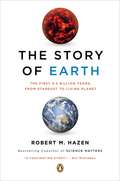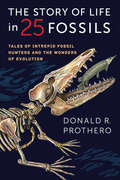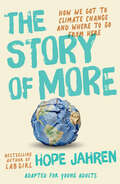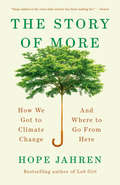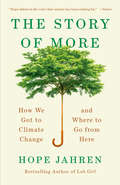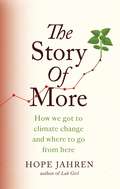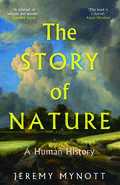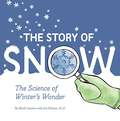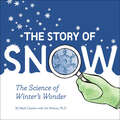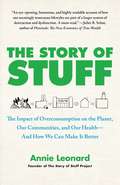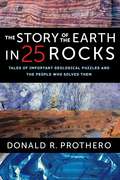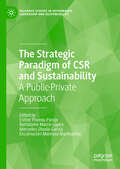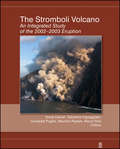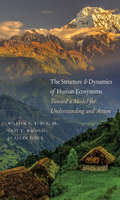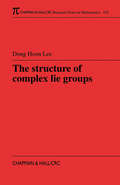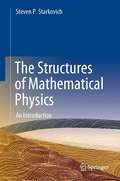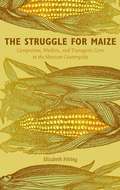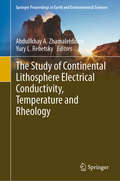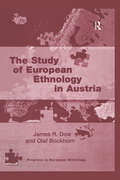- Table View
- List View
The Story of Earth: The First 4.5 Billion Years, from Stardust to Living Planet
by Robert M. HazenEarth evolves. From first atom to molecule, mineral to magma, granite crust to single cell to verdant living landscape, ours is a planet constantly in flux. In this radical new approach to Earth’s biography, senior Carnegie Institution researcher and national bestselling author Robert M. Hazen reveals how the co-evolution of the geosphere and biosphere—of rocks and living matter—has shaped our planet into the only one of its kind in the Solar System, if not the entire cosmos. With an astrobiologist’s imagination, a historian’s perspective, and a naturalist’s passion for the ground beneath our feet, Hazen explains how changes on an atomic level translate into dramatic shifts in Earth’s makeup over its 4. 567 billion year existence. He calls upon a flurry of recent discoveries to portray our planet’s many iterations in vivid detail—from its fast-rotating infancy when the Sun rose every five hours and the Moon filled 250 times more sky than it does now, to its sea-bathed youth before the first continents arose; from the Great Oxidation Event that turned the land red, to the globe-altering volcanism that may have been the true killer of the dinosaurs. Through Hazen’s theory of “co-evolution,” we learn how reactions between organic molecules and rock crystals may have generated Earth’s first organisms, which in turn are responsible for more than two-thirds of the mineral varieties on the planet—thousands of different kinds of crystals that could not exist in a nonliving world. The Story of Earth is also the story of the pioneering men and women behind the sciences. Readers will meet black-market meteorite hawkers of the Sahara Desert, the gun-toting Feds who guarded the Apollo missions’ lunar dust, and the World War II Navy officer whose super-pressurized “bomb”—recycled from military hardware—first simulated the molten rock of Earth’s mantle. As a mentor to a new generation of scientists, Hazen introduces the intrepid young explorers whose dispatches from Earth’s harshest landscapes will revolutionize geology. Celebrated by the New York Times for writing “with wonderful clarity about science . . . that effortlessly teaches as it zips along,” Hazen proves a brilliant and entertaining guide on this grand tour of our planet inside and out. Lucid, controversial, and intellectually bracing, The Story of Earth is popular science of the highest order. .
The Story of Life in 25 Fossils: Tales of Intrepid Fossil Hunters and the Wonders of Evolution
by Donald R. ProtheroEvery fossil tells a story. Best-selling paleontology author Donald R. Prothero describes twenty-five famous, beautifully preserved fossils in a gripping scientific history of life on Earth. Recounting the adventures behind the discovery of these objects and fully interpreting their significance within the larger fossil record, Prothero creates a riveting history of life on our planet. The twenty-five fossils portrayed in this book catch animals in their evolutionary splendor as they transition from one kind of organism to another. We witness extinct plants and animals of microscopic and immense size and thrilling diversity. We learn about fantastic land and sea creatures that have no match in nature today. Along the way, we encounter such fascinating fossils as the earliest trilobite, Olenellus; the giant shark Carcharocles; the "fishibian" Tiktaalik; the "Frogamander" and the "Turtle on the Half-Shell"; enormous marine reptiles and the biggest dinosaurs known; the first bird, Archaeopteryx; the walking whale Ambulocetus; the gigantic hornless rhinoceros Paraceratherium, the largest land mammal that ever lived; and the Australopithecus nicknamed "Lucy," the oldest human skeleton. We meet the scientists and adventurers who pioneered paleontology and learn about the larger intellectual and social contexts in which their discoveries were made. Finally, we find out where to see these splendid fossils in the world's great museums. Ideal for all who love prehistoric landscapes and delight in the history of science, this book makes a treasured addition to any bookshelf, stoking curiosity in the evolution of life on Earth.
The Story of More (Adapted for Young Adults): How We Got to Climate Change and Where to Go from Here
by Hope JahrenThis young adult adaptation of acclaimed geochemist and geobiologist Hope Jahren's highly respected nonfiction work is the perfect book for those interested in learning about climate change and how they can contribute to creating a more sustainable future.Hope Jahren, acclaimed geochemist and geobiologist, details the science behind key inventions, clarifying how electricity, large-scale farming, and automobiles have both helped and harmed our world. Jahren explains the current and projected consequences of unchecked global warming, from superstorms to rising sea levels, resulting from the unprecedented amounts of greenhouse gases being released into our atmosphere. The links between human consumption habits and our endangered existence are very real, with consequences leading to a crossroads of survival and extinction. Still, Jahren maintains that our ever-broadening science-based knowledge can help us counter this dilemma. The eye-opening information provided in The Story of More will help readers understand the path we must take. If we collectively make informed choices now, Jahren reassures us, our future can be as bright as we imagine it can be.
The Story of More: How We Got to Climate Change and Where to Go from Here
by Hope JahrenFrom the bestselling author of Lab Girl comes a slim, urgent missive on the defining issue of our time: here is Hope Jahren on climate change, our timeless pursuit of more, and how the same human ambition that got us here can also be our salvation.Hope Jahren is an award-winning geobiologist, a brilliant writer, and one of the seven billion people with whom we share this earth. The Story of More is her impassioned open letter to humanity as we stand at the crossroads of survival and extinction. Jahren celebrates the long history of our enterprising spirit--which has tamed wild crops, cured diseases, and sent us to the moon--but also shows how that spirit has created excesses that are quickly warming our planet to dangerous levels. In short, highly readable chapters, she takes us through the science behind the key inventions--from electric power to large-scale farming and automobiles--that, even as they help us, release untenable amounts of carbon dioxide into the atmosphere. She explains the current and projected consequences of greenhouse gases--from superstorms to rising sea levels--and shares the science-based tools that could help us fight back. At once an explainer on the mechanisms of warming and a capsule history of human development, The Story of More illuminates the link between our consumption habits and our endangered earth. It is the essential pocket primer on climate change that will leave an indelible impact on everyone who reads it.
The Story of More: How We Got to Climate Change and Where to Go from Here
by Hope Jahren&“Hope Jahren is the voice that science has been waiting for.&” —Nature &“A superb account of the deadly struggle between humanity and what may prove the only life-bearing planet within ten light years, written in a brilliantly sardonic and conversational style.&” —E. O. Wilson&“Hope Jahren asks the central question of our time: how can we learn to live on a finite planet? The Story of More is thoughtful, informative, and—above all—essential.&” —Elizabeth Kolbert, author of The Sixth ExtinctionHope Jahren is an award-winning scientist, a brilliant writer, a passionate teacher, and one of the seven billion people with whom we share this earth. In The Story of More, she illuminates the link between human habits and our imperiled planet. In concise, highly readable chapters, she takes us through the science behind the key inventions—from electric power to large-scale farming to automobiles—that, even as they help us, release greenhouse gases into the atmosphere like never before. She explains the current and projected consequences of global warming—from superstorms to rising sea levels—and the actions that we all can take to fight back. At once an explainer on the mechanisms of global change and a lively, personal narrative given to us in Jahren&’s inimitable voice, The Story of More is the essential pocket primer on climate change that will leave an indelible impact on everyone who reads it.
The Story of More: How We Got to Climate Change and Where to Go from Here
by Hope Jahren'Hope Jahren asks the central question of our time: how can we learn to live on a finite planet? The Story of More is thoughtful, informative and - above all - essential' Elizabeth Kolbert, author of The Sixth ExtinctionHope Jahren is an award-winning geobiologist, a brilliant writer, an inspiring teacher, and one of the seven billion people with whom we share this earth. In The Story of More, Jahren illuminates the link between human consumption habits and our imperiled planet. In short, highly readable chapters, she takes us through the science behind the key inventions - from electric power to large-scale farming and automobiles - that, even as they help us, release untenable amounts of carbon dioxide into the atmosphere. She explains the current and projected consequences of greenhouse gases - from superstorms to rising sea levels - and the actions that all of us can take to fight back. At once an explainer on the mechanisms of warming and a lively, personal narrative given to us in Jahren's inimitable voice, The Story of More is the essential pocket primer on climate change that will leave an indelible impact on everyone who reads it.
The Story of Nature: A Human History
by Jeremy MynottThe story of humanity&’s evolving relationship with the natural world from pre-history to the present day Nature has long been the source of human curiosity and wonderment, and the inspiration for some of our deepest creative impulses. But we are now witnessing its rapid impoverishment, even destruction, in much of our world. In this beautifully illustrated book, Jeremy Mynott traces the story of nature—past, present, and future. From the dramatic depictions of animals by the prehistoric cave-painters, through the romantic discovery of landscape in the eighteenth century, to the climate emergency of the present day, Mynott looks at the different ways in which humankind has understood the world around it. Charting how our ideas about nature emerged and changed over time, he reveals how the impulse to control nature has deep historical roots. As we reach an environmental crisis point, this vital study shows how human imagination and wonder can play a restorative role—and reveal what nature ultimately means to us.
The Story of Snow: The Science Of Winter's Wonder (Into Reading, Read Aloud Module 6 #2)
by Mark Cassino Jon Nelson Nora AoyagiNIMAC-sourced textbook <p><p> How do snow crystals form? What shapes can they take? Are no two snow crystals alike? These questions and more are answered inside this exploration of the science of snow, featuring photos of real snow crystals in all their beautiful diversity. Perfect for reading on winter days, this book by a nature photographer and a snow scientist will inspire wonder and curiosity about the marvels of snow. Snowflake-catching instructions are also included for aspiring young snow scientists!
The Story of Snow: The Science of Winter's Wonder
by Mark Cassino Jon NelsonHow do snow crystals form? What shapes can they take? Are no two snow crystals alike? These questions and more are answered in this visually stunning exploration of the science of snow. Perfect for reading on winter days, the book features photos of real snow crystals in their beautiful diversity. Snowflake-catching instructions are also included.
The Story of Stuff: How Our Obsession with Stuff Is Trashing the Planet, Our Communities, and Our Health-and a Vision for Change
by Annie LeonardA classic exposé in company with An Inconvenient Truth and Silent Spring, The Story of Stuff expands on the celebrated documentary exploring the threat of overconsumption on the environment, economy, and our health. Leonard examines the &“stuff&” we use everyday, offering a galvanizing critique and steps for a changed planet.The Story of Stuff was received with widespread enthusiasm in hardcover, by everyone from Stephen Colbert to Tavis Smiley to George Stephanopolous on Good Morning America, as well as far-reaching print and blog coverage. Uncovering and communicating a critically important idea—that there is an intentional system behind our patterns of consumption and disposal—Annie Leonard transforms how we think about our lives and our relationship to the planet. From sneaking into factories and dumps around the world to visiting textile workers in Haiti and children mining coltan for cell phones in the Congo, Leonard, named one of Time magazine’s 100 environmental heroes of 2009, highlights each step of the materials economy and its actual effect on the earth and the people who live near sites like these. With curiosity, compassion, and humor, Leonard shares concrete steps for taking action at the individual and political level that will bring about sustainability, community health, and economic justice. Embraced by teachers, parents, churches, community centers, activists, and everyday readers, The Story of Stuff will be a long-lived classic.
The Story of the Earth in 25 Rocks: Tales of Important Geological Puzzles and the People Who Solved Them
by Donald R. ProtheroEvery rock is a tangible trace of the earth’s past. The Story of the Earth in 25 Rocks tells the fascinating stories behind the discoveries that shook the foundations of geology. In twenty-five chapters—each about a particular rock, outcrop, or geologic phenomenon—Donald R. Prothero recounts the scientific detective work that shaped our understanding of geology, from the unearthing of exemplary specimens to tectonic shifts in how we view the inner workings of our planet. Prothero follows in the footsteps of the scientists who asked—and answered—geology’s biggest questions: How do we know how old the earth is? What happened to the supercontinent Pangea? How did ocean rocks end up at the top of Mount Everest? What can we learn about our planet from meteorites and moon rocks? He answers these questions through expertly chosen case studies, such as Pliny the Younger’s firsthand account of the eruption of Vesuvius; the granite outcrops that led a Scottish scientist to theorize that the landscapes he witnessed were far older than Noah’s Flood; the salt and gypsum deposits under the Mediterranean Sea that indicate that it was once a desert; and how trying to date the age of meteorites revealed the dangers of lead poisoning. Each of these breakthroughs filled in a piece of the greater puzzle that is the earth, with scientific discoveries dovetailing with each other to offer an increasingly coherent image of the geologic past. Summarizing a wealth of information in an entertaining, approachable style, The Story of the Earth in 25 Rocks is essential reading for the armchair geologist, the rock hound, and all who are curious about the earth beneath their feet.
The Story of the Gold at Sutter's Mill (Cornerstones of Freedom)
by R. Conrad SteinPresents the scene in California after gold was discovered on John Sutter's land in 1849 and the subsequent fortunes made and hearts broken.
The Story of the Johnstown Flood (Cornerstones of Freedom)
by R. Conrad SteinDescribes the devastating tidal wave that hit the city of Johnstown and several Pennsylvania villages on Memorial Day, 1889, when the South Fork Dam above the city collapsed as a result of spring rains.
The Story of the San Francisco Earthquake (Cornerstones of Freedom)
by R. Conrad SteinDescribes the devastating earthquake and ensuing fire that destroyed much of San Francisco in the spring of 1906.
The Strategic Paradigm of CSR and Sustainability: A Public-Private Approach (Palgrave Studies in Governance, Leadership and Responsibility)
by Bartolomé Marco-Lajara Esther Poveda-Pareja Mercedes Úbeda-García Encarnación Manresa-MarhuendaIt has become increasingly clear that promotion of sustainability initiatives by governments and other public institutions alone is not enough to bring about the necessary progress in tackling the ‘Grand Challenges’ of climate change and inequality. A higher level of involvement is required from companies, as the main agents of economic development. Therefore, research is needed to determine how the desired levels of sustainability can be achieved through each of the spheres (public and private) as well as by considering collaboration between both. This book analyses Corporate Social Responsibility (CSR) and sustainability from a public-private perspective, considering the actions of stakeholders belonging to both the private and public scopes, their ability to collaborate and the paradigmatic relationship between CSR and sustainability as it moves across the public and private spheres. It will be of great interest to students and scholars of sustainability strategy, CSR, policy and corporate governance, as well as internal and external stakeholders engaged in corporate policy and strategic management.
The Stratosphere: Dynamics, Transport, and Chemistry
by L. M. Polvani A. H. Sobel D. W. WaughPublished by the American Geophysical Union as part of the Geophysical Monograph Series, Volume 190. <P><P> The Stratosphere: Dynamics, Transport, and Chemistry is the first volume in 20 years that offers a comprehensive review of the Earth's stratosphere, increasingly recognized as an important component of the climate system. The volume addresses key advances in our understanding of the stratospheric circulation and transport and summarizes the last two decades of research to provide a concise yet comprehensive overview of the state of the field. This monograph reviews many important aspects of the dynamics, transport, and chemistry of the stratosphere by some of the world's leading experts, including up-to-date discussions of Dynamics of stratospheric polar vortices Chemistry and dynamics of the ozone hole Role of solar variability in the stratosphere Effect of gravity waves in the stratosphere Importance of atmospheric annular modes This volume will be of interest to graduate students and scientists who wish to learn more about the stratosphere. It will also be useful to atmospheric science departments as a textbook for classes on the stratosphere.
The Stromboli Volcano
by Maurizio Ripepe Sonia Calvari Giuseppe Puglisi Salvatore Inguaggiato Mauro RosiPublished by the American Geophysical Union as part of the Geophysical Monograph Series, Volume 182.This book presents a study of the "eruptive crisis" that took place at the Stromboli volcano from December 2002 to July 2003.<P><P> It features an integrative approach to the monitoring of eruptive activity, including lava flow output, explosive activity, flank instability, submarine and subaerial landslides, tsunami, paroxysmal explosive events, and mitigation strategies.The book comes with a DVD with spectacular photos and video ofThe landslide and the tsunami that hit the coast of the island;The 5 April 2003 paroxysmal event;The whole eruption showing the stages of effusive activity and growth of the lava flow field;Selected data useful for testing geochemical, petrological, seismological, thermal, and ground deformation models.This multidisciplinary and multimedia experience, unique for the amount, quality, and variety of data it covers, can be applied to other active volcanoes. Stromboli will appeal to solid Earth scientists and students working in seismology, geodynamics, geochemistry, and mineral physics, as well as nonspecialists with an interest in the inner workings of our planet and others.
The Structure and Dynamics of Human Ecosystems: Toward a Model for Understanding and Action
by William R. Burch Gary E. Machlis Jo Ellen ForceA landmark book that strives to provide both grand theory and practical application, innovatively describing the structure and dynamics of human ecosystems As the world faces ever more complex and demanding environmental and social challenges, the need for interdisciplinary models and practical guidance becomes acute. The Human Ecosystem Model described in this landmark book provides an innovative response. Broad in scope, detailed in method, at once theoretical and applied, this grand study offers an in-depth understanding of human ecosystems and tools for action. The authors draw from Goethe’s Faust, classic anthropology and sociology studies, contemporary ecosystem ecology, Buddhist ethics, and more to create a paradigm-shifting model and a major advance in interdisciplinary ecology.
The Structure of Complex Lie Groups (Chapman & Hall/CRC Research Notes in Mathematics Series)
by Dong Hoon LeeComplex Lie groups have often been used as auxiliaries in the study of real Lie groups in areas such as differential geometry and representation theory. To date, however, no book has fully explored and developed their structural aspects.The Structure of Complex Lie Groups addresses this need. Self-contained, it begins with general concepts
The Structures of Mathematical Physics: An Introduction
by Steven P. StarkovichThis textbook serves as an introduction to groups, rings, fields, vector and tensor spaces, algebras, topological spaces, differentiable manifolds and Lie groups --- mathematical structures which are foundational to modern theoretical physics. It is aimed primarily at undergraduate students in physics and mathematics with no previous background in these topics. Applications to physics --- such as the metric tensor of special relativity, the symplectic structures associated with Hamilton's equations and the Generalized Stokes's Theorem --- appear at appropriate places in the text. Worked examples, end-of-chapter problems (many with hints and some with answers) and guides to further reading make this an excellent book for self-study. Upon completing this book the reader will be well prepared to delve more deeply into advanced texts and specialized monographs in theoretical physics or mathematics.
The Struggle for Maize: Campesinos, Workers, and Transgenic Corn in the Mexican Countryside
by Elizabeth FittingWhen scientists discovered transgenes in local Mexican corn varieties in 2001, their findings intensified a debate about not only the import of genetically modified (GM) maize into Mexico but also the fate of the peasantry under neoliberal globalization. While the controversy initially focused on the extent to which gene flow from transgenic to local varieties threatens maize biodiversity, anti-GM activists emphasized the cultural significance of the crop in Mexico and demanded that campesinos and consumers have a voice in the creation of GM maize and rural policies. In The Struggle for Maize, Elizabeth Fitting explores the competing claims of the GM corn debate in relation to the livelihood struggles of small-scale maize producers, migrants, and maquiladora workers from the southern Tehuacn Valley. She argues that the region's biodiversity is affected by state policies that seek to transform campesinos into entrepreneurs and rural residents into transnational migrant laborers. While corn production and a campesino identity remain important to an older generation, younger residents have little knowledge of or interest in maize agriculture; they seek out wage labor in maquiladoras and the United States. Fitting's ethnography illustrates how agricultural producers and their families respond creatively to economic hardship and Mexico's "neoliberal corn regime," which promotes market liberalization, agricultural "efficiency," and the reduction of state services over domestic maize production and food sovereignty.
The Study of Continental Lithosphere Electrical Conductivity, Temperature and Rheology (Springer Proceedings in Earth and Environmental Sciences)
by Abdullkhay A. Zhamaletdinov Yury L. RebetskyThis proceedings book investigates the possibilities for creating new models of the continental lithosphere structure by integrating methods from geothermodynamics and deep geoelectrics. It particularly focuses on the use of powerful controlled sources of electromagnetic field to study the nature of deep geophysical boundaries. It also presents research related to the transition boundary between the brittle and quasiplastic states of Earth’s crust matter and the position of creep areas in Earth’s crust, as well as geothermal and rheological studies in combination with the deep electromagnetic soundings – a promising direction that allows the tectonophysical reconstruction of natural stresses in the lithosphere. The experimental study results and tectonophysical modeling are discussed in the context of the Fennoscandinavian shield, the Indian Craton, the Himalayas, Eastern Tibet and the Eurasian continent as a whole. The book appeals to researchers interested in solid Earth physics.
The Study of European Ethnology in Austria (Progress in European Ethnology)
by James R. Dow Olaf BockhornThe study of ethnology or ’Volkskunde’ in Austria has had a troubled past. Through most of the 20th century it was under the influence of the so-called Viennese ’Mythological School’ and the controversy between the two opposing branches, the ’Ritualist’ and the ’Mythologists', set much of the agenda from the 1920s until long after the World War ended in 1945. The volume examines two Austrian characters, Richard Wolfram and Karl Haiding, and the impact of their research and sets them in the context of Austrian ethnology before, during and after the war years. The book concludes by examining the present day ethnological outlook in the country.
